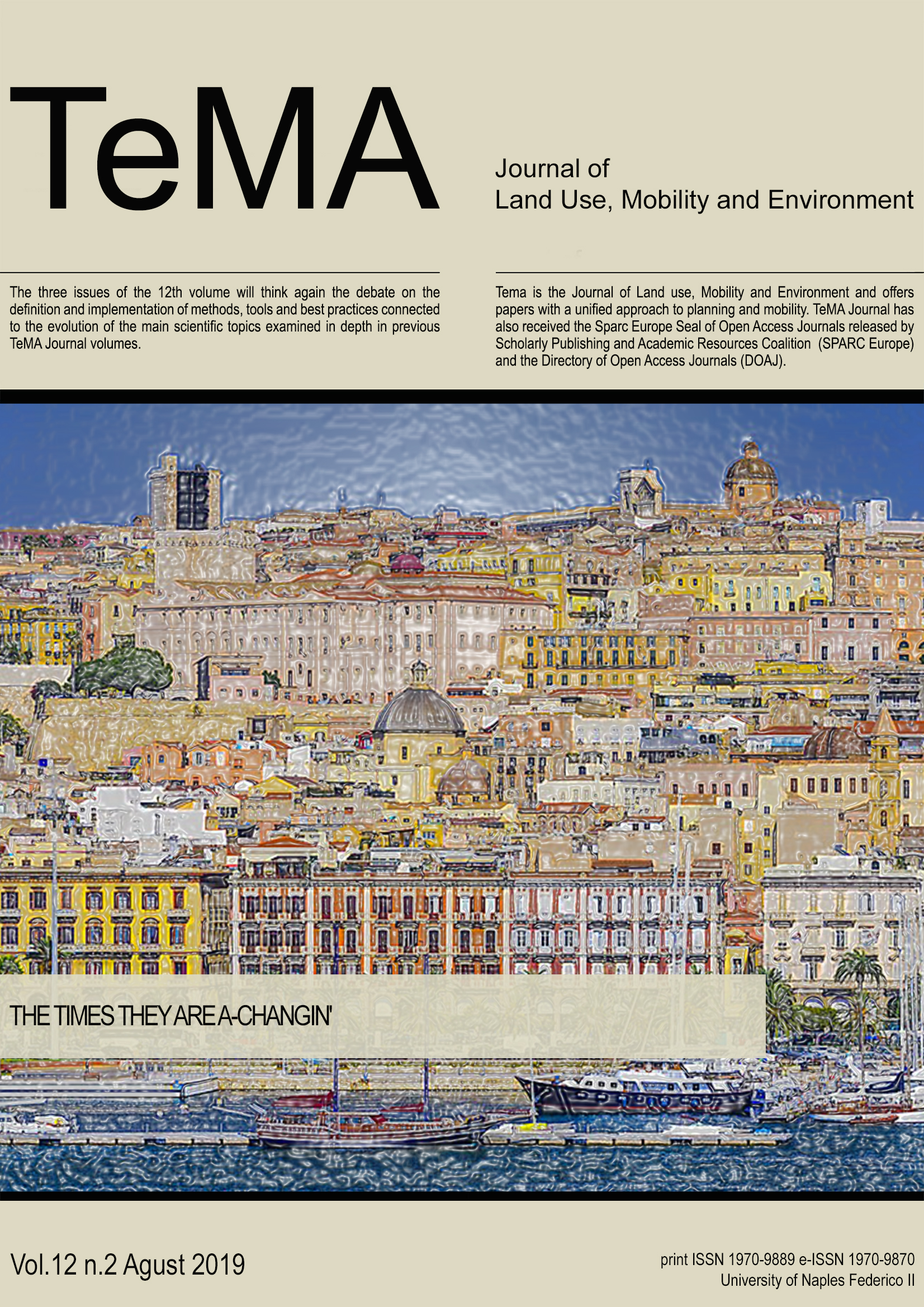Walkability and Urban Design in a Post-Earthquake City
Abstract
The research described in this article concerns the issue of accessibility with a focus on the walkability in a city that is under reconstruction, such as the city of L'Aquila struck by a destructive earthquake in 2009. The reconstruction is determining a new urban layout in which there is a chaotic overlap of flows of the movements of vehicles and people, quite exceptional with respect to the configuration of an ordinary city. For example, the flows of heavy vehicles and work machines, linked to building reconstruction, and which also generate strong noise pollution and therefore a new soundscape, increase considerably. It is a city in which the return to the residences mixes with large building sites, in which urban transformations are very fast and must be governed through appropriate urban design instruments.
The main aim of this research is to define a strategy to realize a method able to calculate at the same time an overlapping indexes in order to classify streets according to how friendly they are for the pedestrian and bike. This theme is approached to a methodological level and is related to the interacting theme of urban design and new centralities. The tool used for this integration is the Strategic Urban Project, which the research experience has found to be more effective and with greater performance than the more traditional Land Use Planning. The design approach and methodology is to integrate urban design techniques with spatial planning techniques, in order to obtain a higher performance of pedestrian networks.
Downloads
References
Albrechts, L., (2006). Bridge the Gap: From Spatial Planning to Strategic Projects. European Planning Studies, 14:10, 1487-1500. Doi: https://doi.org/10.1080/09654310600852464.
Barton, H., (1998). Eco-neighbourhoods: a review of projects. Local Environment, 3, 159-177. Doi: https://doi.org/10.1080/13549839808725555.
Brand, D. and Nicholson, H. (2016). Public space and recovery: learning from post-earthquake Christchurch. Journal of Urban Design. 21:2, 159-176. Doi: https://doi.org/10.1080/13574809.2015.1133231.
Bono, F. and Gutiérrez, E., (2011). A network-based analysis of the impact of structural damage on urban accessibility following a disaster: the case of the seismically damaged Port Au Prince and Carrefour urban road networks. Journal of Transport Geography, 19, 1443–1455. Doi: https://doi.org/doi:10.1016/j.jtrangeo.2011.08.002.
Calthorpe, P., (1993). The Next American Metropolis: Ecology, Community and the American Dream. Princeton Architectural Press, New York.
Cresa, (2011). I caratteri di fondo dell’area del sisma. In: L’Abruzzo e il cratere sismico: economie a confronto prima e dopo il terremoto. Congiuntura Economica Abruzzese, 1.
D’Ascanio, F., Di Ludovico, D. and Di Lodovico, L., (2016). Design and urban shape for a resilient city. Procedia Social and Behavioral Sciences, 223, 764-769. Doi: https://doi.org/10.1016/j.sbspro.2016.05.265.
De Vico, B., Di Ludovico, D. and Colagrande, S., (2014). A new infrastructural-relation model for the post-earthquake city of L’Aquila. In: The Sustainable City IX Urban Regeneration and Sustainability. Wit transactions on ecology and the environment, 191, 221-232, https://doi.org/10.2495/SC140191.
Di Ludovico, D. and Properzi, P., (2018). Territori fragili vs Territori smart. Urbanistica Informazioni, 278, 18-22.
Di Ludovico, D., (2017). Il Progetto urbanistico, prove di innovazione per il futuro della città. Aracne editrice. Roma.
Di Ludovico, D., Properzi, P. and Graziosi, F., (2014). From a smart city to a smart up-country. The new city-territory of L’Aquila. TEMA Journal, Special issue, 353-364. Doi: http://dx.doi.org/10.6092/1970-9870%2F2482.
Di Ludovico, D. and Properzi, P., (2012). Progetti urbani e Progetti urbanistici nel governo dei paesaggi post-urbani. Planum, 25, 1-6.
Di Ludovico, D. and D’Ovidio, G., (2017). Transportation Network Role for Central Italy Macroregion Development in a Territorial Frames Model Based. IOP Conference series: materials science and engineering, 245, 1-10. Doi: http://dx.doi.org/10.1088/1757-899X/245/4/042039.
Dittmar, H. and Poticha, S., (2004). Defining transit-oriented development: the new regional building block. In: Dittmar, H., Ohland, G. (Eds.), The New Transit Town: Best Practices in Transit-Oriented Development. Island Press. Washington, Covelo, London. 19–40.
D'Ovidio, G., Di Ludovico, D. and La Rocca, G. L., (2016). Urban Planning and Mobility Critical Issues in Post-Earthquake Configuration: L’Aquila City Case Study. Procedia Engineering, 161, 1815-1819, Doi: https://doi.org/10.1016/j.proeng.2016.08.670.
Duany, A., Speck, J. and Lydon, M., (2010). The Smart Growth Manual. McGraw–Hill. New York.
EC, (2013). Building a Green Infrastructure for Europe. Publications Office of the European Union. Luxembourg. Doi: https://doi.org/10.2779/54125.
Espon, (2005). ESPON 1.1.1 Potentials for polycentric development in Europe - Project report. Espon. Luxembourg.
Fekete, A. and Fiedrich, F., (2018), Urban Disaster Resilience and Security: Addressing Risks in Societies. Spinger International.
Jenks, M., Burton, E. and Williams, K., eds (2005), The Compact City: A Sustainable Urban Form?, Spon Press. Taylor & Francis. London and New York.
Touraine, A., (2010), Après la crise. Edition de Seuil. Paris.
Vale, D.S., (2015), Transit-oriented development, integration of land use and transport, and pedestrian accessibility: Combining node-place model with pedestrian shed ratio to evaluate and classify station areas in Lisbon. Journal of Transport Geography. 45, 70-80. Doi: https://doi.org/10.1016/j.jtrangeo.2015.04.009.
Copyright (c) 2019 TeMA - Journal of Land Use, Mobility and Environment

This work is licensed under a Creative Commons Attribution 4.0 International License.
Authors who publish in this journal agree to the following:
1. Authors retain the rights to their work and give in to the journal the right of first publication of the work simultaneously licensed under a Creative Commons License - Attribution that allows others to share the work indicating the authorship and the initial publication in this journal.
2. Authors can adhere to other agreements of non-exclusive license for the distribution of the published version of the work (ex. To deposit it in an institutional repository or to publish it in a monography), provided to indicate that the document was first published in this journal.
3. Authors can distribute their work online (ex. In institutional repositories or in their website) prior to and during the submission process, as it can lead to productive exchanges and it can increase the quotations of the published work (See The Effect of Open Access)

